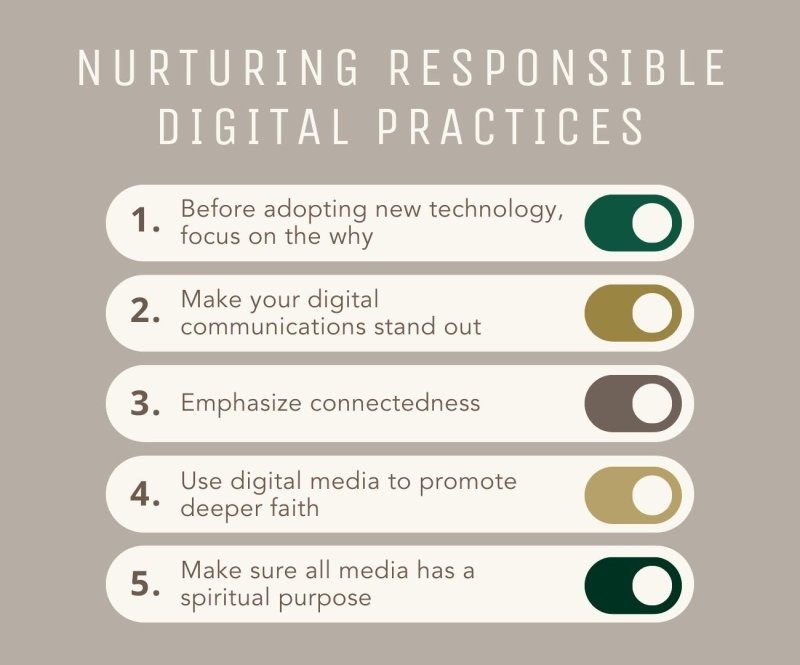
For millennia, the Christian church has sought to adapt itself to new technologies, taking advantage of the opportunities they offer to reach even more people for Christ.
Whether it’s through the invention of the printing press in 1440 which opened the way for the common person to access the Bible on a personal level, or through online church service innovations brought forth by the Covid-19 pandemic, the Church has had to adapt itself to new changes in technology since time immemorial.
However, the process of adaptation can often be slow-going. That has certainly been the case with the digital age. Although churches and ministries have made major strides in adapting to the digital age, the effectiveness of such adaptations are still important to discuss as church leaders try to balance technology’s benefits and challenges.
Despite the difficulties, churches and ministries should open themselves up to adapting to our increasingly digital world. If employed responsibly and thoughtfully, integrating technology in ministry can help boost ministry opportunities in the digital age, allowing for greater reach and impact.
The changing ministry landscape
The digital ecosystem we find ourselves in continues to grow and expand at an exponential pace. Whether it’s completing basic tasks through voice activated tech, transitioning into online banking or spending more time on social media, it’s evident that the digital age is here to stay.
This has presented a unique challenge to religious leaders as they navigate this new social, political and economic reality in their communities. Pretending that digital culture does not exist is not an option. The church must adapt.
The last several years present a great example. Before the Covid-19 pandemic, the only churches who offered online services were large churches or those with many resources. During the pandemic, many churches had to scramble to find online solutions to their church activities, since social distancing measures kept congregants from meeting one another in person.
What was meant to be a temporary solution for some churches has now become the ministry standard as more and more churches embrace a hybrid service model where congregants can attend both online and in person.
______
Who are you called to be?
Pursue your purpose at PLNU.
______
According to Pushpay’s State of Church Technology Report, 9 out of 10 churches surveyed say they offer the hybrid church service model. Out of those churches, 81 percent say they play on continuing this model into the future.
Churches now champion online services as an opportunity to reach even more people. Online services also allow for greater inclusivity. Congregants who suffer from health issues that prevent them from leaving their homes are now able to join services online. Online services are also a great way to include those that often have to work on Sundays, or have moved away from the church location.
The technological landscape in ministry is not just evident through the online church phenomenon, but is also present in other changes in how churches and ministries run their operations.
Many churches are now encouraging congregants to use an app or text messaging service to give tithes and offerings. They are ramping up social media use and messaging to attract new members, expanding their email newsletter network to keep members up to date on events hosted by the church, and more.
The role of technology in ministry
Churches and ministries offer something that is often missing in today’s world: strong and intentional community. As such, technology in ministry has always had the role to help facilitate the formation and strengthening of relationships.
Churches have employed the use of certain digital mediums to help foster connections including the following:
- Websites
- Blogs
- Social Media
- Email Newsletters
In addition to community building, ministries and churches often seek to equip and teach their congregants so as to lead to greater knowledge and spiritual growth. Within the new digital landscape we’ve seen the rise of:
- Sermons posted on video-sharing platforms like YouTube
- Podcasts focused on particular themes
- Sermons posted weekly in podcast format
- Snippets of sermons shared via short-form video tools like Instagram’s Reels or TikTok
When it comes to day-to-day church operations and logistics, many churches have made use of software to help facilitate such operations. In fact, according to the Pushpay report, 94 percent of churches consider technology to be an important aspect of their day-to-day mission work.
A clear example is the use of scheduling software like Planning Center by worship ministries. In addition, church employees may also use platforms like Zoom or Slack to facilitate day-to-day communication.
The role of social media in church ministry
Social media, in particular, has greatly changed the ministry landscape.
In the past, church attendants used to visit a church without knowing much about it beforehand. Now, it’s likely that a person will check out a church’s Instagram page or watch an online service on YouTube before visiting.
As such, it is important for churches to be mindful of their social media strategy and take it seriously. There are many benefits for investing in a robust social media strategy for your church. Here are a few as provided by Social Pilot:
Social media can help churches boost community
- Can keep communities informed about social events and gatherings
- Can help communicate a church’s values directly to their followers
- Can encourage followers to share their testimonies and encouragement in the comment section
Social media helps churches reach new people
- Can help churches reach people quickly and more efficiently
- Can help churches reach younger generations
Social media is relatively affordable
- Most digital marketing strategies like ads are not as expensive as physical ads would be
- Creating a social media account is free in most instances, but churches can access added benefits for relatively small fees.
If used intentionally, social media can be used to provide spiritual encouragement to a church’s congregants, offering them opportunities to reflect on and engage with their faith in more day-to-day experiences.
Challenges that come with the digital age
The use of new media and technology can be a blessing but it can also pose many challenges.
For instance, adapting to new technologies in churches doesn’t always go right, as evidenced by the recent failed attempt to successfully launch an AI-led church in Germany. An overreliance on online services has led some to advocate for the elimination of online church altogether.
Adapting to how people consume media can be a way to retain congregants. On the other hand, it can take away from crucial parts of the church experience, such as meeting together and having meaningful in-person relationships — things that are arguably lacking in today’s digitally driven society that churches are uniquely designed to provide. Given this challenging landscape, it’s important to responsibly employ the use of technology so as to help mitigate these factors.
Nurturing responsible digital practices

We’ve all felt it before.
Dependency on technology like cell phones and social media has impacted how we connect with each other, and has arguably impaired our ability to have meaningful in-person conversations. Studies have shown that a heavy use of social media can lead to depression and anxiety, especially among young people.
These are real challenges brought on by the digital age.
The beauty of the church is that it is uniquely positioned to help deal with some of these issues, providing communities with a place for personal connection, care and love. The good news is that the church does not have to do away with technology in order to live out this unique mission. It just needs to use it responsibly.
Here are a few tips on how to do so:
Before adopting new technology, focus on the why
First, it’s important to focus on the why before adopting any type of new technology. As suggested by Faith Lead, the goal for churches “shouldn’t be to adopt every new technology” but “to study digital culture to find areas of overlap with” one’s “mission and vision.”
Opening up a social media account on every newly launched platform is not effective and can lead to social media burnout both for church employees and congregants. It’s important to narrow down the use of digital media to a church’s mission and values.
Make your digital communications stand out
Let’s face it, we are already bombarded with seemingly endless notifications day in and day out. Receiving even more from our churches just adds to the noise. Instead, make your digital communications stand out. Design social media posts and emails so that they actually add value to people’s lives rather than just being another noisy notification.
- What are some impactful moments from last week’s service you can share throughout the week?
- What are some of the events you can promote through an email campaign that will lead to greater community connectedness?
- What can you share that will lift congregants’ spirits as they scroll through their often crowded feeds?
- Be mindful and particular about your communication so as to add to people’s well-being rather than simply adding to the noise.
Emphasize connectedness
Shape your digital media use in ways that will lead people to meet offline more often. Whether it’s providing opportunities for connection between congregants or simply sharing local events and get-togethers, digital media can be a great gateway tool to help people get off their phones to meet and have fellowship with one another.
Use digital media to promote deeper faith
Whether it’s reminding congregants to rewatch last Sunday’s sermon or posting encouraging verses, digital media can be a great tool to help encourage congregants in their faith, leading them to pause and reflect on their walk with God throughout the day.
Make sure all media has a spiritual purpose
Above all else, make sure that the ultimate goal is to lead people to a closer relationship with Christ. You can send out meaningful emails with a teaching moment, upload short devotionals on TikTok or YouTube Shorts, encourage theological reflection through a social media post. Whatever it is, keep in mind that digital media is simply a tool to lead others closer to Christ.
If you’d like to learn more about how to responsibly integrate technology into church and ministry, consider obtaining a Master of Arts in Christian Ministry. Not only will it help you live out your God-given calling for ministry, it will equip you to navigate today’s ministerial landscape in the digital age.
